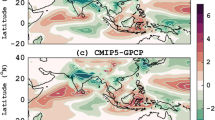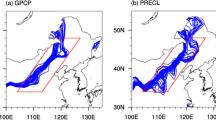Abstract
This study addresses several significant drawbacks in our previous analyses of how Australian summer monsoon onset/retreat may respond to global warming in CMIP3 model simulations. We have analysed daily 850 hPa wind, volumetric precipitable water, precipitation and temperature data from 26 CMIP5 models over a pair of 55-year simulations. Firstly, the CMIP5 models do not show significant improvement in capturing observed features of the monsoon onset/retreat in the region, despite of a slightly reduced bias in multi-model ensemble results. We show that wind–rainfall relationship varies with models and rainfall-based wet season onsets may not adequately represent the monsoon development. Under global warming, although 26-model averages show delayed onset and shortened duration, significant uncertainty exists: 10 models simulated delayed onset but it became earlier in another group of 7 models. Similar model discrepancies are seen in the modelled changes in retreat dates. The range of uncertainty in the projected changes is similar in CMIP3 and CMIP5 models and further analysis re-affirms previously proposed reasons: one is the different influence of a number of drivers in these models and the other is the different changes in these drivers themselves in future climate. Overall, most of the models showed impacts of ENSO and the Indian Ocean on the Australian summer monsoon onset/retreat, but the models differed quite significantly in the magnitude of such impacts. Another factor is different warming patterns and magnitudes in the tropical Pacific and Indian Oceans. When combined, the two provide a better explanation of the scatter among the 26 CMIP5 model results.














Similar content being viewed by others
References
Aldrian E, Susanto RD (2003) Identification of three dominant rainfall regions within Indonesia and their relationship to sea surface temperature. Int J Climatol 23(12):1435–1452
Berry GJ, Reeder MJ, Jakob C (2012) Coherent synoptic disturbances in the Australian monsoon. J Clim 25:8409–8421
Cai W, Cowan T, Sullivan A (2009a) Recent unprecedented skewness towards positive Indian Ocean Dipole occurrences and its impact on Australian rainfall. Geophys Res Lett 36:L11705. doi:10.1029/2009GL037604
Cai W, Sullivan A, Cowan T (2009b) Rainfall teleconnections with Indo-Pacific variability in the WCRP CMIP3 models. J Clim 22:5046–5071
Cai W, Cowan T, Sullivan A (2009c) Climate change contributes to more frequent consecutive positive Indian Ocean Dipole events. Geophys Res Lett 36:L23704. doi:10.1029/2009GL040163
Christensen JH et al (2013) Climate phenomena and their relevance for future regional climate change. In: Climate change 2013: the physical science basis. Contribution of Working Group I to the Fifth Assessment Report of the Intergovernmental Panel on Climate Change. Cambridge University Press, Cambridge, UK
Chu J-E, Ha K-J, Lee J-Y, Wang B, Kim B-H, Chung CE (2014) Future change of the Indian Ocean basin-wide and dipole modes in the CMIP5. Clim Dyn 43:535–551
Colman RA, Moise AF, Hanson L (2011) Tropical Australian climate and the Australian monsoon as simulated by 23 CMIP3 models. J Geophys Res 116:D10116. doi:10.1029/2010JD015149
CSIRO and Bureau of Meteorology (2007) Climate change in Australia: technical report. http://www.climatechangeinaustralia.gov.au
CSIRO and Bureau of Meteorology (2012) State of the climate 2012. http://www.csiro.au/Outcomes/Climate/Understanding/State-of-the-Climate.aspx
Davidson NE, Tory KJ, Reeder MJ, Drosdowsky WL (2007) Extratropical–tropical interaction during onset of the Australian monsoon: reanalysis diagnostics and idealized dry simulations. J Atmos Sci 64:3475–3498
Dong G, Zhang H, Moise A, Hanson L, Liang P, Ye H (2015) CMIP5 model-simulated onset, duration and intensity of the Asian summer monsoon in current and future climate. Clim Dyn. doi:10.1007/s00382-015-2588-z
Drosdowsky W (1996) Variability of the Australian summer monsoon at Darwin: 1957–1992. J Clim 9:85–96
Evans SM, Marchand RT, Ackerman TP, Beagle N (2012) Identification and analysis of atmospheric states and associated cloud properties for Darwin, Australia. JGR 117:D06204. doi:10.1029/2011JD017010
Frederiksen CS, Frederiksen JS (1996) A theoretical model of Australian northwest cloudband disturbances and southern hemisphere storm tracks: the role of SST anomalies. J Atmos Sci 53:1410–1432
Guan Z, Ashok K, Yamagata T (2003) Summertime response of the tropical atmosphere to the Indian Ocean Dipole sea surface temperature anomalies. J Meteorol Soc Jpn 81:533–561
Hendon HH, Liebmann B (1990) A composite study of onset of the Australian summer monsoon. J Atmos Sci 47:2227–2240
Hendon HH, Lim E, Wheeler MC (2011) Seasonal prediction of Australian summer monsoon rainfall. In: Chang C-P, Ding YH, Lau N-C, Johnson R, Wang B, Yasunari T (eds) The Global monsoon system: research and forecast, vol 5, 2nd edn. World Scientific Series on Asia-Pacific Weather and Climate, pp 73–84
Hung C-W, Yanai M (2004) Factors contributing to the onset of the Australian summer monsoon. Q J R Meteorol Soc 130:739–758
IPCC (Intergovernmental Panel on Climate Change) (2007) Climate change 2007: the physical science basis. In: Solomon S (ed) Contribution of Working Group I to the Fourth Assessment Report of the IPCC. Cambridge University Press, Cambridge
IPCC (Intergovernmental Panel on Climate Change) (2013) Climate change 2013: the physical science basis. In: Stocker TF (ed) Contribution of Working Group I to the Fifth Assessment Report of the IPCC. Cambridge University Press, Cambridge
Irving DB, Whetton P, Moise AF (2012) Climate projections for Australia: a first glance at CMIP5. Aust Meteorol Oceanogr J 62:211–225
Jourdain NC, Sen Gupta A, Taschetto AS, Ummenhofer CC, Moise AF, Ashok K (2013) The Indo-Australian monsoon and its relationship to ENSO and IOD in reanalysis data and the CMIP3/CMIP5 simulations. Clim Dyn 41:3073–3102
Kawamura R, Fukuta Y, Ueda H, Matsuura H, Iizuka S (2002) A mechanism of the onset of the Australian summer monsoon. J Geophys Res 107:4204. doi:10.1029/2001JD001070
Kim KY, Kullgren K, Lim GH, Boo KO, Kim BM (2006) Physical mechanism of the Australian summer monsoon: 2. Variability of strength and onset and termination times. J Geophys Res 111:D20105. doi:10.1029/2005JD006808
Kitoh A, Endo H, Kumar KK, Cavalcanti IFA, Goswami P, Zhou T (2013) Monsoons in a changing world: a regional perspective in a global context. J Geophys Res 118:3053–3065
Kullgren K, Kim KY (2006) Physical mechanism of the Australian summer monsoon: 1. Seasonal cycle. J Geophys Res 111:20104. doi:10.1029/2005JD006807
Lavender S, Abbs D (2013) Trends in Australian rainfall: contribution of tropical cyclones and closed lows. Clim Dyn 40:317–326
Li J, Zeng Q (2003) A new monsoon index and the geographical distribution of the global monsoons. Adv Atmos Sci 20:299–302
Liu L, Xie SP, Zheng XT, Li T, Du Y, Huang G, Yu WD (2013) Indian Ocean variability in the CMIP5 multi-model ensemble: the zonal dipole mode. Clim Dyn. doi:10.1007/s00382-013-2000-9
Liu B, Wu G, Ren R (2014) Influence of ENSO on the vertical coupling of atmospheric circulation during the onset of South Asian Summer monsoon. Clim Dyn. doi:10.1007/s00382-014-2439-3
Mizuta R, Arakawa O, Ose T, Kusunoki S, Endo H, Kitoh A (2014) Classification of CMIP5 future climate responses by the tropical sea surface temperature changes. SOLA 10:167–171. doi:10.2151/sola.2014-035
Moise AF, Colman RA, Brown JR (2012) Behind uncertainties in projections of Australian tropical climate: analysis of 19 CMIP3 models. J Geophys Res 117:D10103. doi:10.1029/2011JD017365
Morton V, Robertson AW, Boer R (2009) Spatial coherence and seasonal predictability of monsoon onset over Indonesia. J Clim 22:840–850
Nicholls N, McBride JL, Ormerod RJ (1982) On predicting the onset of the Australian wet season at Darwin. Mon Weather Rev 110:14–17
Pope M, Jakob C, Reeder MJ (2009) Regimes of the North Australian wet season. J Clim 22:6699–6715
Power S, Delage F, Chung C, Kociuba G, Keay K (2013) Robust twenty-first-century projections of El Nino and related precipitation variability. Nature 502(7472):541–545. doi:10.1038/nature12580
Rotstayn LD, Jeffrey SJ, Collier MA, Dravitzki SM, Hirst AC, Syktus JI, Wong KK (2012) Aerosol- and greenhouse gas-induced changes in summer rainfall and circulation in the Australasian region: a study using single-forcing climate simulations. Atmos Chem Phys 12:6377–6404
Saji B, Goswami N, Vinayachandran PN, Yamagata T (1999) A dipole mode in the tropical Indian Ocean. Nature 401:360–363
Saji NH, Xie SP, Yamagata T (2006) Tropical Indian Ocean variability in the IPCC twentieth-century climate simulations. J. Clim 19:4397–4417
Smith IN, Wilson L, Suppiah R (2008) Characteristics of the northern Australian rainy season. J Clim 21:4298–4311
Suppiah R, Collier MA, Rotstayn LD, Syktus JI, Wong KK (2013) Simulated and projected summer rainfall in tropical Australia: links to atmospheric circulation using the CSIRO Mk3.6 climate model. Aust Meteorol Oceanogr J 63:15–26
Taschetto AS, Haarsma RJ, Gupta AS, Ummenhofer CC, Hill KJ, England MH (2010) Australian monsoon variability driven by a Gill-Matsuno-type response to central west Pacific warming. J Clim 23:4717–4735
Taylor KE, Stouffer RJ, Meehl GA (2012) An overview of CMIP5 and the experiment design. Bull Am Meteorol Soc 93(4):485–498
Ummenhofer CC, England MH, McIntosh PC, Meyers GA, Pook MJ, Risbey JS, Gupta AS, Taschetto AS (2009) What causes southeast Australia’s worst droughts? Geophys Res Lett 36:L04706. doi:10.1029/2008GL036801
Wardle R, Smith I (2004) Modeled response of the Australian monsoon to changes in land surface temperatures. Geophys Res Lett 31:L16205. doi:10.1029/2004GL020157
Watterson IG (2012) Understanding and partitioning future climates for Australian regions from CMIP3 using ocean warming indices. Clim Change 111:903–922
Weller E, Cai W (2014) Realism of the Indian Ocean dipole in CMIP5 models: the implications for climate projections. J Clim 26:6649–6659
Wheeler MC, McBride JL (2005) Australian-Indonesian monsoon. In: Lau WKM, Waliser DE (eds) Intraseasonal variability in the atmosphere–ocean climate system. Springer, Berlin, pp 125–173
Wheeler MC, McBride JL (2012) Australasian monsoon. In: Lau WKM, Waliser DE (eds) Intraseasonal variability in the atmosphere–ocean climate system. Springer, Berlin, pp 147–198
Xie SP, Deser C, Vecchi GA, Ma J, Teng H, Wittenberg AT (2010) Global warming pattern formation: sea surface temperature and rainfall. J Clim 23:966–986. doi:10.1175/2009JCLI3329.1
Xue Y, Smith TM, Reynolds RW (2003) Interdecadal changes of 30-yr SST normals during 1871–2000. J Clim 16:1601–1612
Zeng X, Lu E (2004) Globally unified monsoon onset and retreat indexes. J Clim 17:2241–2248
Zhang H (2010) Diagnosing Australia-Asian monsoon onset/retreat using large-scale wind and moisture indices. Clim Dyn 35:601–618
Zhang H, Moise A (2014) The Australian summer monsoon in current and future climate. In: Jones C, Carvalhobook L (eds) Monsoons and climate. Springer, Berlin (to be published)
Zhang CJ, Zhang H (2010) Potential impacts of east Asian winter monsoon on climate variability and predictability in the Australian summer monsoon region. Theor Appl Climatol. doi:10.1007/s00704-009-0246-2
Zhang H, Moise A, Liang P, Hanson L (2013) The response of summer monsoon onset/retreat in Sumatra–Java and tropical Australia region to global warming in CMIP3 models. Clim Dyn 40:377–399
Acknowledgments
The project is partially supported by the Australian Climate Change Science Programme. Mr. GuangTao Dong’s visit to CAWCR in 2013 was through the bilateral collaborations between Australian Bureau of Meteorology and the China Meteorological Administration. The authors acknowledge useful discussions with Dr. I. Smith and appreciate the thoughtful comments from Drs. S. Grainger and G. Roff on an earlier draft and very thoughtful comments from two anonymous reviewers. We acknowledge the World Climate Research Programme’s Working Group on Coupled Modelling, which is responsible for CMIP, and we the climate modelling groups (see Table 1) for producing and making available their model output. For CMIP the US Department of Energy’s PCMDI provides coordinating support and led development of software infrastructure in partnership with the Global Organization for Earth System Science Portals.
Author information
Authors and Affiliations
Corresponding author
Rights and permissions
About this article
Cite this article
Zhang, H., Dong, G., Moise, A. et al. Uncertainty in CMIP5 model-projected changes in the onset/retreat of the Australian summer monsoon. Clim Dyn 46, 2371–2389 (2016). https://doi.org/10.1007/s00382-015-2707-x
Received:
Accepted:
Published:
Issue Date:
DOI: https://doi.org/10.1007/s00382-015-2707-x




